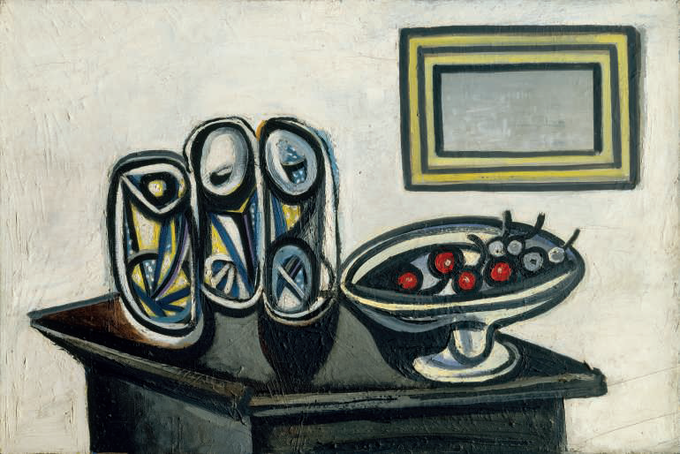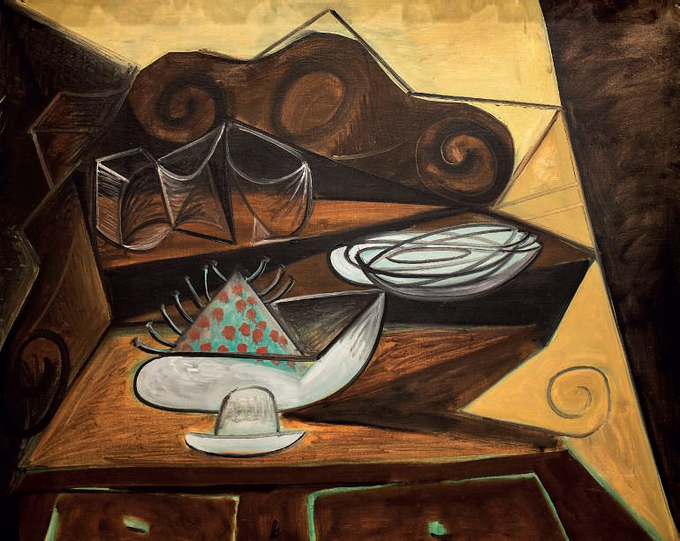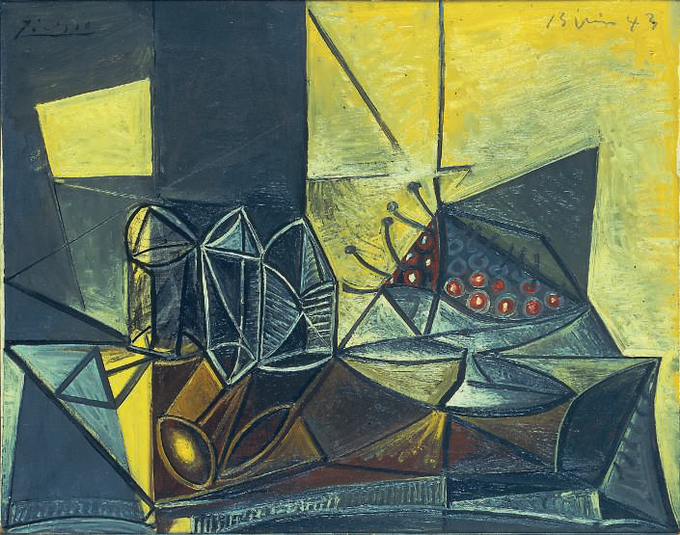Pablo Picasso Compotier et verres
Pablo Picasso (1881-1973)
Compotier et verres
dated ‘14 juin 43’ (upper right); dated again '14 juin 43' (on the reverse)
oil on canvas
21½ x 28¾ in. (54.5 x 73 cm.)
Painted on 14 June 1943
Compotier et verres
dated ‘14 juin 43’ (upper right); dated again '14 juin 43' (on the reverse)
oil on canvas
21½ x 28¾ in. (54.5 x 73 cm.)
Painted on 14 June 1943
Compotier et verres is one of a series of three still-life paintings featuring three glasses and a bowl of cherries upon a tabletop that Pablo Picasso painted on 14 June 1943. Throughout the month Picasso painted five other variations of these quotidian motifs in an intense burst of creativity as he explored the dynamic relationship between these objects (Zervos, vol. XIII, nos. 51-58). With a starkly reduced palette, Compotier et verres is one of the most simplified and striking of this series, exemplifying the artist’s supreme handling of form: the glasses and fruit bowl appear to have been painted without Picasso’s brush leaving the canvas, an undulating and dynamic thread of bold black lines against a startling white background. Yet this austere and arresting painting also reflects darker concerns: primarily, life in occupied Paris. Though in the majority of his wartime production Picasso did not directly reference the war, through the genre of still-life, the artist powerfully evoked the bleak realities and the constant angst of living in the shadow of conflict. Gone are the abundant colours and sensuous forms that govern Picasso’s earlier still-lifes of the 1930s, and in their place a sombre restraint and haunting power. ‘Above all’, Frances Morris has written, ‘it was the still-life genre that Picasso developed into a tool capable of evoking the most complex blend of pathos and defiance, of despair to hope, balancing personal and universal experience in an expression of extraordinary emotional power. The hardship of daily life, the fragility of human existence and the threat of death are themes that haunt Picasso’s still-life paintings of the war and Liberation periods’ (F. Morris, Paris Post War, Art and Existentialism 1945-1955, exh. cat., London, 1993, p. 155).
Just a few weeks before he painted Compotier et verres, Picasso had met Françoise Gilot. Aged 21, this youthful, dark-haired painter had caught the 61-year-old artist’s eye while they were both dining at Le Catalan, a restaurant often frequented by Picasso due to its proximity to his studio on the rue des Grands Augustins. Picasso, who was with his current lover and muse, Dora Maar, implored Gilot’s dining companion, the actor Alain Cuny, to introduce him to the young painter, bringing a bowl of cherries to their table. Gilot later recalled their first encounter: ‘As the meal went on I noticed Picasso watching us, and from time to time acting a bit for our benefit… Whenever he said something particularly amusing, he smiled at us rather than just at his dinner companions. Finally, he got up and came over to our table. He brought with him a bowl of cherries and offered some to all of us, in his strong Spanish accent, calling them cerisses, with a soft, double-s sound’ (F. Gilot & C. Lake, Life with Picasso, New York, 1964, p. 14).
Picasso was immediately taken by Françoise and invited her to visit his studio and see his work. Over the following weeks, she returned on numerous occasions and so marked the beginning of an enduring romance, one which would last for the next decade and produce two children, Claude and Paloma. From this point onwards, the motif of a bowl abundantly filled with cherries frequently appeared in Picasso’s still-lifes, a sign of Françoise’s presence in the artist’s life, and, with their plentiful abundance and ruby-red colour, this fruit also served as a symbol of luxury and indulgence against the backdrop ?of war.
Despite many of his friends offering to aid the artist in fleeing the occupied French capital, Picasso decided resolutely to remain in his beloved Paris. Declared a ‘degenerate’ artist by Hitler’s regime and purportedly prohibited from exhibiting his work in Paris, Picasso increasingly retreated to his studio, entertaining friends and visitors there and withdrawing from the café culture that had characterised his life in Paris for years. In order to prevent crossing Paris every day, in September 1940, the artist left his apartment on the rue La Boétie in the fashionable Right Bank and moved into his vast studio on the rue des Grands Augustins on the Left Bank. Though spacious, the studio was freezing, which, combined with food shortages, blackouts and electricity rationing, made these years some of the darkest of his life.
In the face of these deprivations and upheavals, Picasso worked with a ceaseless enthusiasm, remaining highly productive throughout these war years. ‘It was not a time for the creative man to fail, to shrink, to stop working’, Picasso explained after the Liberation in 1944, ‘there was nothing else to do but work seriously and devotedly, struggle for food, see friends quietly, and look forward to freedom’ (Picasso, quoted in M. McCully, ed., A Picasso Anthology: Documents, Criticism, Reminiscences, Princeton, 1981, p. 224). Due to his isolation, Picasso primarily painted his immediate surroundings, resulting in the proliferation of still-life paintings. Françoise Gilot’s memory of one of her first visits to Picasso’s studio in May 1943 describes the artist’s abundant production at this time: ‘[Picasso] piled [his paintings] up almost like scaffolding. There was a painting on the easel; he stuck another on top of that; one on each side; piled others on top of those… That morning there were cocks; a buffet of Le Catalan with cherries against a background of brown, and white; small still lifes, some with lemon and many with glasses, a cup, and a coffeepot, or with fruit against ?a checked tablecloth’ (Gilot, ibid., p. 20).
Though the artist’s style did not change during this period, Picasso pushed his distinctive stylistic distortions, deformations and exaggerations to the extreme, as exemplified by Compotier et verres. Picasso often painted in the evening and at night, illuminating his studio with spotlights. The shadowless setting of Compotier et verres, the unadorned background and the stark palette of black and white is perhaps a reflection of this, imbuing the painting with a haunting intensity and dramatic visual power that characterises the greatest of Picasso’s work from this turbulent, unsettling and dark period. Looking back on this period, the artist reflected, ‘I have not painted the war because I am not the kind of painter who goes out like a photographer for something to depict. But I have no doubt that the war is in these paintings I have done. Later on perhaps the historians will find them and show that my style has changed under the war’s influence’ (Picasso, quoted in S.A. Nash, ed., Picasso and the War Years 1937-1945, exh. cat., San Francisco & New York, 1999, p. 13).
Just a few weeks before he painted Compotier et verres, Picasso had met Françoise Gilot. Aged 21, this youthful, dark-haired painter had caught the 61-year-old artist’s eye while they were both dining at Le Catalan, a restaurant often frequented by Picasso due to its proximity to his studio on the rue des Grands Augustins. Picasso, who was with his current lover and muse, Dora Maar, implored Gilot’s dining companion, the actor Alain Cuny, to introduce him to the young painter, bringing a bowl of cherries to their table. Gilot later recalled their first encounter: ‘As the meal went on I noticed Picasso watching us, and from time to time acting a bit for our benefit… Whenever he said something particularly amusing, he smiled at us rather than just at his dinner companions. Finally, he got up and came over to our table. He brought with him a bowl of cherries and offered some to all of us, in his strong Spanish accent, calling them cerisses, with a soft, double-s sound’ (F. Gilot & C. Lake, Life with Picasso, New York, 1964, p. 14).
Picasso was immediately taken by Françoise and invited her to visit his studio and see his work. Over the following weeks, she returned on numerous occasions and so marked the beginning of an enduring romance, one which would last for the next decade and produce two children, Claude and Paloma. From this point onwards, the motif of a bowl abundantly filled with cherries frequently appeared in Picasso’s still-lifes, a sign of Françoise’s presence in the artist’s life, and, with their plentiful abundance and ruby-red colour, this fruit also served as a symbol of luxury and indulgence against the backdrop ?of war.
Despite many of his friends offering to aid the artist in fleeing the occupied French capital, Picasso decided resolutely to remain in his beloved Paris. Declared a ‘degenerate’ artist by Hitler’s regime and purportedly prohibited from exhibiting his work in Paris, Picasso increasingly retreated to his studio, entertaining friends and visitors there and withdrawing from the café culture that had characterised his life in Paris for years. In order to prevent crossing Paris every day, in September 1940, the artist left his apartment on the rue La Boétie in the fashionable Right Bank and moved into his vast studio on the rue des Grands Augustins on the Left Bank. Though spacious, the studio was freezing, which, combined with food shortages, blackouts and electricity rationing, made these years some of the darkest of his life.
In the face of these deprivations and upheavals, Picasso worked with a ceaseless enthusiasm, remaining highly productive throughout these war years. ‘It was not a time for the creative man to fail, to shrink, to stop working’, Picasso explained after the Liberation in 1944, ‘there was nothing else to do but work seriously and devotedly, struggle for food, see friends quietly, and look forward to freedom’ (Picasso, quoted in M. McCully, ed., A Picasso Anthology: Documents, Criticism, Reminiscences, Princeton, 1981, p. 224). Due to his isolation, Picasso primarily painted his immediate surroundings, resulting in the proliferation of still-life paintings. Françoise Gilot’s memory of one of her first visits to Picasso’s studio in May 1943 describes the artist’s abundant production at this time: ‘[Picasso] piled [his paintings] up almost like scaffolding. There was a painting on the easel; he stuck another on top of that; one on each side; piled others on top of those… That morning there were cocks; a buffet of Le Catalan with cherries against a background of brown, and white; small still lifes, some with lemon and many with glasses, a cup, and a coffeepot, or with fruit against ?a checked tablecloth’ (Gilot, ibid., p. 20).
Though the artist’s style did not change during this period, Picasso pushed his distinctive stylistic distortions, deformations and exaggerations to the extreme, as exemplified by Compotier et verres. Picasso often painted in the evening and at night, illuminating his studio with spotlights. The shadowless setting of Compotier et verres, the unadorned background and the stark palette of black and white is perhaps a reflection of this, imbuing the painting with a haunting intensity and dramatic visual power that characterises the greatest of Picasso’s work from this turbulent, unsettling and dark period. Looking back on this period, the artist reflected, ‘I have not painted the war because I am not the kind of painter who goes out like a photographer for something to depict. But I have no doubt that the war is in these paintings I have done. Later on perhaps the historians will find them and show that my style has changed under the war’s influence’ (Picasso, quoted in S.A. Nash, ed., Picasso and the War Years 1937-1945, exh. cat., San Francisco & New York, 1999, p. 13).
 |
Pablo Picasso, Bufet, 1943. Musée des Beaux-Arts, Lyon.
|
 |
Pablo Picasso, Compotier et verres, 1943. The Kreeger Museum, Washington D.C.
|
 |
Pablo Picasso, Bufet, 1943. The Menil Collection, Houston.
|
.jpg)
Comments
Post a Comment